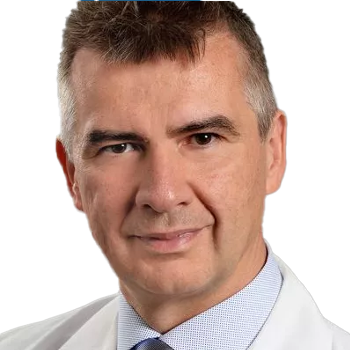To access AIS Channel content, please allow all cookies. Please click here to configure your preferences.
We present to you a 58-year-old female with a BMI of 35. She has multiple failed attempts for weight loss. She has many medical problems (HBP, T2DM, CAD, OSA, COPD, IBS, CKD) as well as a surgical history significant for a Nissen fundoplication.
First we performed an assessment of the stomach. The mid-stomach at the retro-gastric space was clear. The patient did, however, need an extensive adhesionlysis, starting at the liver edge.
We then made our way to the medial posterior aspect and took down these adhesions. This was done using hook catheter. We performed an early division of the stomach to aid with our visualization of the posterior aspect of our soon-to-be pouch. These posterior attachments were further taken down.
We now focused our attention to the anterior portion of the stomach. In this area, there are denser adhesions of the stomach. We switched our instruments and used a robotic Harmonic to aid in our blunt dissection and also energy dissection. We use this device to get through our thicker tissues to open up softer planes, especially at the hiatus.
As you can see, we are able to visualize the wrap, which is coming up posteriorly to the native stomach. We follow this wrap circumferentially and take down more attachments until this wrap is completely free from the surrounding structures and from the stomach.
We protect the stomach anteriorly and push our wrap away. As you can see, we are able to visualize the stomach, GE junction, esophagus and hiatus. We insert a gastroscope to help us identify our proximal stomach in preparation for a pouch.
We use a laparoscopic stapling device to create a pouch using the lighted scope and as a guide. We ended up making our pouch 5 x 7 cm using three stapler loads. We wanted to make a larger pouch for improved vasculature and mobilization of our revised stomach.
Looking back at the hiatus, the patient had a very large hiatal hernia. During our dissection, we found that some of the fundoplicated stomach had herniated into this area. We perform a primary closure of the hiatal hernia using non-absorbable suture. Use of the robotic arms helps us do this rather nicely.
Now we focus on creating our gastro-jejunal anastomosis. Not shown here is the creation of our jejuno-jejunal anastomosis. We did this in a standard manner: we used a 150 cm roux limb placed in an anti-colic position. We performed also a hand-sewn J-J anastomosis which is not shown. The roux limb and the pouch are brought together using the robotic instruments.
A stake suture is placed and we use the same long suture to start our posterior layer of suture. The third robotic arm is used for retraction. This is done the entire length of the gastric pouch along our roux limb. We use our hook catheter to perform our gastrotomy and enterotomy. We make our opening to approximately 2 cm. We then perform a hand-sewn anastomosis using two long sutures.
We do this in the usual manner. The use of the robotic arms helps us to do this with great precision, especially when going around the corners. The use of the third robotic arm is also advantageous for retraction, as we could switch these arms to have continued retraction.
As our standard practice, we insert a gastroscope through our anastomosis. This serves to stent our anastomosis open as we close our anastomosis over the scope using the existing suture. Again, the use of our robotic arms helps us to do this with great precision.
We perform an anterior layer of suture to protect the anastomosis. This is done the entire length of the pouch. We then close the mesenteric defect. Lastly, we perform endoscopy and the leak test, which are both negative for leak.
This is the picture of our resected stomach. As you can see, the fundoplication still takes shape.
Our patient did well and had an upper GI negative for leak. She was discharged to home on day three. In select patients, robotic approaches to revisional bariatric surgery are feasible and safe, and allow for superb operative technique.
Robotic surgery should be performed by an experienced operator and surgical team for improved surgical times and outcomes.

